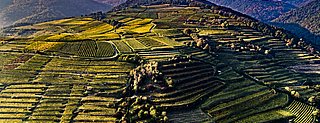
Seiberberg
Facts:
- Town:
- Weißenkirchen
- Subsites:
- Hochseiber
- Size in ha:
- 38,67
- Altitude in m:
- 262 - 470
- Aspect:
- SW - E
- Average Slope in %:
- 26
- Max. Slope in %:
- 74
- Insolation in hours per year:
- 2181
- Terraced vineyard:
- Yes
- Distance to Danube in m:
- 979
- Labour required in h:
- 17.400
- First documentary evidence:
- 1378
Description
No other vineyard in Weißenkirchen climbs to such heights. Vines are cultivated here up to an elevation of 466 m. The portion of the Seiber adjacent to the forest, which is dedicated to viticulture, exhibits diverse conditions due to the great differences in elevation.
Soil Profile Hinter Seiber
In his research paper from 1882, geologist F. Becke mentions among other things the "Seyberer gneiss" near Weißenkirchen. The Seiber slope is composed of a particularly diverse paragneiss complex with various enclaves. The profile comes from the highest elevations of the Hinter-Seiber vineyard. The soil is an example of the very shallow and meagre Ranker soil type. The thin layer of soil with humus accumulation lies directly over a carbonate-free "Seyber gneiss". The meagre soil and the longer vegetation period in the most elevated vineyard of the Wachau produce crystal-clear, firm wines with moderate alcohol content.







